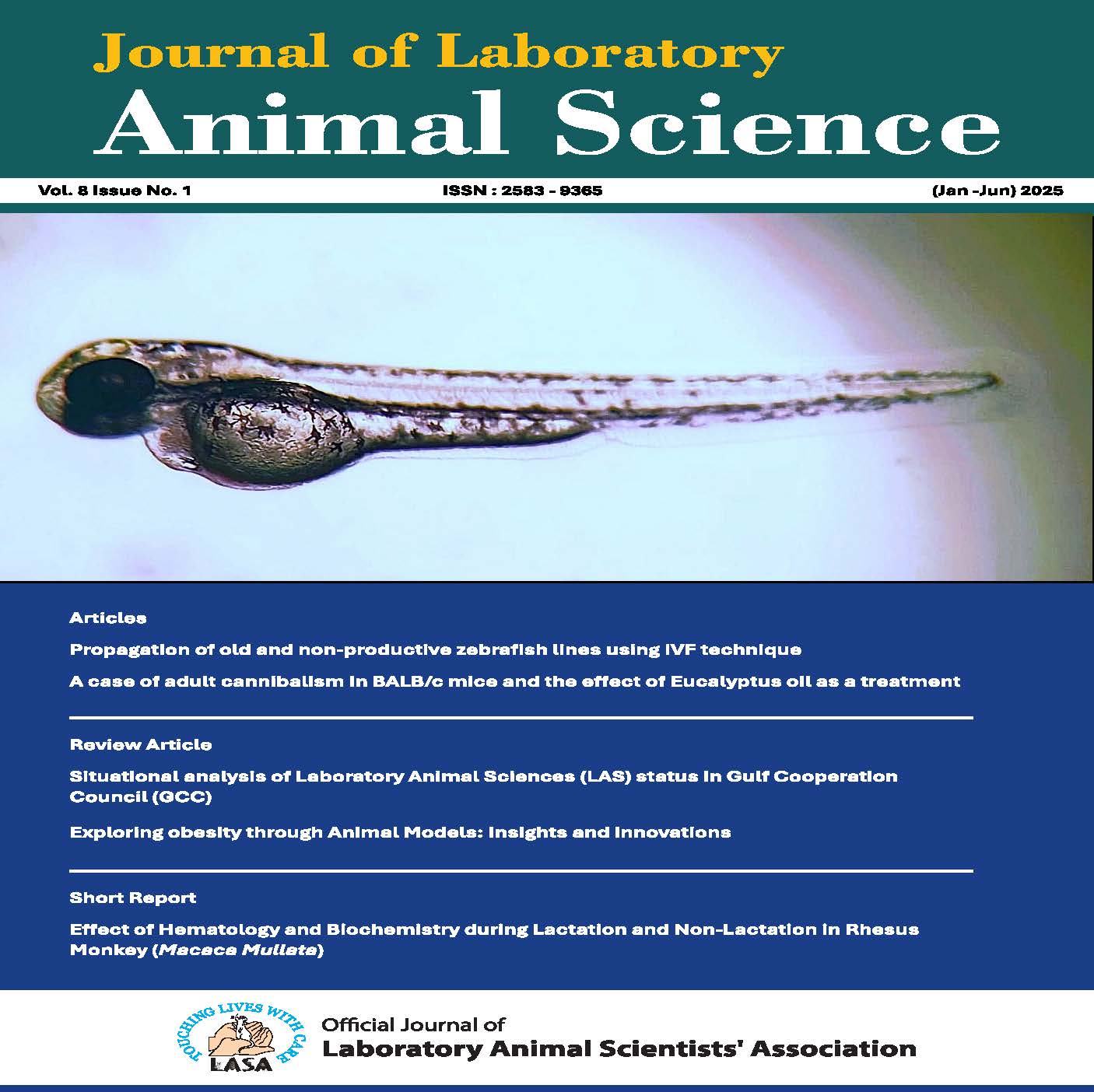Antimicrobial effects of grapefruit seed extract microfibers against mouse hepatitis virus, Escherichia coli, Staphylococcus aureus, and Pseudomonas aeruginosa
DOI:
https://doi.org/10.48165/jlas.2024.7.1.1Keywords:
Antimicrobial, disinfectant, grapefruit seed extract, microfiberAbstract
Grapefruit seed extract (GSE), which contains flavonoids, possesses antibacterial, antiviral, and antifungal properties. This study investigated the antimicrobial activity of cellulose-bound GSE microfibers against mouse hepatitis virus (MHV) for three weeks and against Escherichia coli, Staphylococcus aureus, and Pseudomonas aeruginosa for one week. The disinfectant was smeared on a petri dish to inactivate the MHV for three weeks or to prevent the growth of the selected bacteria for one week. As the disinfectant effect lasted at least one week, GSE microfibers could have applications in disinfecting laboratory animal facilities. The virus or bacteria mixed with the disinfectant did not cause cytopathic effects in the cells or growth on the media after one week.
Downloads
References
1. Al–Âni WN, Tawfik NO, Shehab EY (2011). Antimicrobial activity of grapefruit seeds extracts (in vitro study). Al– Rafidain Dent. J. 11(2):341-345.
2. Alonso D, Gimeno M, Sepúlveda-Sánchez, JD, Shirai K (2010). Chitosan-based microcapsules containing grapefruit seed extract grafted onto cellulose fibers by a non-toxic procedure. Carbohydr. Res. 345(6):854-859.
3. Block MS, Rowan BG (2020). Hypochlorous acid: a review J. Oral Maxillofac. Surg. 78(9):1461-1466.
4. Dembinski A, Warzecha Z, Konturek SJ, et al. (2004). Extract of grapefruit-seed reduces acute pancreatitis induced by ischemia/reperfusion in rats: possible implication of tissue antioxidants. J. Physiol. Pharmacol. 55(4):811-821.
5. Goto K, Kuwayama E, Nozu R, Ueno M, Hayashimoto N (2015). Effect of hypochlorous acid solution on the eradication and prevention of Pseudomonas aeruginosa infection, serum biochemical variables, and cecum microbiota in rats. Exp. Anim. 64(2):191-197.
6. Goto K, Nozu R, Kunita S, Terada E, Itoh T (1995). Genotyping of mouse hepatitis virus strains by restriction endonuclease analysis of amplified nucleocapsid protein genes. Exp. Anim. 44(2):159-161.
7. Han HW, Kwak JH, Jang TS, et al. (2021). Grapefruit seed extract as natural derived antibacterial substance against multidrug-resistant bacteria. Antibiotics. 10(1):85.
8. Hayashimoto N, Morita H, Ishida T, et al. 2013. Current microbiological status of laboratory mice and rats in experimental facilities in Japan. Exp. Anim. 62(1):41-48.
9. Heggers JP, Cottingham J, Gusman J, et al. (2002). The effectiveness of processed grapefruit-seed extract as an antibacterial agent: II. Mechanism of action and in vitro toxicity. J. Altern. Complement Med. 8(3):333-340.
10. Hirano N, Fujiwara K, Matumoto M (1976). Mouse hepatitis virus (MHV-2) plaque assay and propagation in mouse cell line DBT cells. Japan J. Microbiol. 20(3):219-225.
11. Jung S, Ko BS, Jang HJ, Park HJ, Oh SW (2018). Effect of slightly acidic electrolyzed water ice and grapefruit
after smearing with the GSE microfiber solution. Prolonged disinfection is beneficial for the management of animal facilities. However, the toxicity of this disinfectant has not yet been reported. Therefore, we conclude that the GSE microfiber is a promising tool for disinfecting animal facilities
seed extract ice on shelf life of brown sole (Pleuronectes herzensteini). Food Sci. Biotechnol. 27:261-267.
12. Kim JH, Kwon KH, Oh SW (2016). Effects of malic acid or/ and grapefruit seed extract for the inactivation of common food pathogens on fresh-cut lettuce. Food Sci. Biotechnol. 25:1801-1804.
13. Komura M, Suzuki M, Sangsriratanakul N, et al. (2019). Inhibitory effect of grapefruit seed extract (GSE) on avian pathogens. J. Vet. Med. Sci. 81(3):466-472.
14. Migliarina F, Ferro S (2014). A modern approach to disinfection, as old as the evolution of vertebrates. Healthcare. 2(4):516-526.
15. Phan DN, Khan MQ, Nguyen VC, et al. (2022). Investigation of mechanical, chemical, and antibacterial properties of electrospun cellulose-based scaffolds containing orange essential oil and silver nanoparticles. Polymers. 14(1):85.
16. Sagripanti JL, Bonifacino A (2000). Resistance of Pseudomonas aeruginosa to liquid disinfectants on contaminated surfaces before formation of biofilms. J. AOAC Int. 83(6):1415-1422.
17. Vanamala J, Reddivari L, Yoo KS, Pike LM, Patil BS (2006). Variation in the content of bioactive flavonoids in different brands of orange and grapefruit juices. J. Food Compos. Anal.19(2-3)157-166.
18. Vanamala J, Reddivari L, Yoo KS, Pike LM, Patil BS (2006). Variation in the content of bioactive flavonoids in different brands of orange and grapefruit juices. J. Food Compos. Anal. 19(2-3)157-166.doi: 10.1016/j.jfca.2005.06.002.
19. Xiong H, Li Y, Slavik MF, Walker JT (1998). Spraying chicken skin with selected chemicals to reduce attached Salmonella typhimurium. J. Food Prot. 61(3):272-275.
20. Xu WT, Huang KL, Guo F, et al. (2007). Postharvest grapefruit seed extract and chitosan treatments of table grapes to control Botrytis cinerea. Postharvest Biol. Technol. 46(1):86-94.
21. Yang SK, Kim JJ, Kim SJ, Oh SW (2011). Synergistic effect of grapefruit seed extract, EDTA and heat o inactivation of Bacillus cereus spore. J. Korean Soc. Food. Sci. Nutr. 40(10):1469-1473.

